Beauty Product Classification: A Practical Guide
When navigating the world of beauty, Beauty Product Classification, the system that groups products based on purpose, ingredients and regulatory rules. Also known as beauty product taxonomy, it helps shoppers, professionals and regulators tell what's a serum, a lipstick or a shampoo at a glance. Beauty product classification isn’t just paperwork; it shapes what you can buy, how you use it, and whether a claim like "organic" holds water.
One of the biggest buckets under this system is Skincare, products designed to cleanse, protect or treat the skin. Skincare includes cleansers, moisturizers, serums and sunscreens, each with its own ingredient list and safety standards. Because skin is the body’s first barrier, regulations often require detailed labeling of actives like retinol or niacinamide. This means classification directly influences formulation choices and consumer trust.
Next up is Cosmetics, items applied to accentuate or change appearance, such as makeup, fragrance and color cosmetics. Cosmetics are judged by a different set of rules—focus is on color, texture, and allergen disclosures rather than therapeutic benefit. The line between a cosmetic and a skincare product can blur; a tinted moisturizer may sit in both categories, demanding careful classification to meet both sets of standards.
Then there’s Hair Care, products that clean, condition, style or treat hair and scalp. From salon‑grade shampoos to DIY hair masks, hair care items must pass specific tests for strip‑residue, pH balance and fragrance safety. Classification here matters for professionals who recommend salon‑grade vs. consumer‑grade items and for regulators checking claims like "damaged hair repair".
Why Classification Matters for Every Buyer
First, classification sets expectations. If a product is labeled as skincare, you expect it to support skin health, not just add sparkle. Second, it guides pricing and marketing. Luxury cosmetics often leverage a “premium” classification to justify higher price points, while drugstore skincare competes on efficacy and affordability. Third, it affects safety compliance; mis‑classifying a product can lead to recalls or legal trouble.
In practice, the system works like this: beauty product classification encompasses sub‑categories (skincare, cosmetics, hair care). It requires clear labeling (ingredients, usage instructions). And it influences consumer decisions—people who prioritize natural ingredients will look for classifications that highlight organic or cruelty‑free status. All these pieces connect to form a reliable shopping experience.
Our collection below reflects how classification shows up in real‑world topics. You’ll find deep dives into salon hair products, organic claims for brands like Eminence, the truth behind medical‑grade skincare, and practical guides for beginners wanting to set up a simple routine. Whether you’re a seasoned pro or just starting, these posts illustrate how the right classification helps you pick products that actually work for you.
Ready to see these ideas in action? Below you’ll discover detailed articles that break down each category, compare top brands, and give you step‑by‑step tips to make the most of your beauty stash.
Three Classifications of Cosmetics Explained
Learn the three main classifications of cosmetics-cleansing, protective, and decorative-plus how they differ in purpose, ingredients, and regulations.

 Hair Care
Hair Care